Review Article | DOI: https://doi.org/10.58489/2833-0943/021
Attributes, uses, and management of Dovyalis caffra (Kei apple) A Review of literature
- Eguale Tadesse* 1,2
1Department of Environmental Science and Ecological Engineering, Korea University, 145 Anam-ro, Seongbuk-gu, Seoul 02841,
2Ethiopian Environment and Forest Research Institute (EEFRI), 24536 Addis Ababa, Ethiopia;
*Corresponding Author: Eguale Tadesse
Citation: Eguale Tadesse (2023). Attributes, uses, and management of Dovyalis caffra (Kei apple) A Review of literature. Pesticide Science and Pest Control. 1(2). DOI: 10.58489/2833-0943/021
Copyright: ©2023 Eguale Tadesse, this is an open-access article distributed under the Creative Commons Attribution License, which permits unrestricted use, distribution, and reproduction in any medium, provided the original work is properly cited.
Received: 10 May 2023 | Accepted: 08 July 2023 | Published: 13 July 2023
Keywords: allelopathy; distribution; live fence; propagation; pruning; recalcitrant; rimming;
Abstract
The objective of this review is to explore information about D. caffra and get good ideas about future research requirements and development activities. Dovyalis caffra (Warb.) (Kei apple) which belongs to the family Flacourtacea is a thorny evergreen tree/shrub native to the Kei River area of southwest Africa and abundant in the wild around the eastern Cape, Kaffraria, and Natal. It is now found distributed in many countries of the world including Ethiopia. Propagation of D. caffra is mostly by seed but its propagation is also possible vegetatively using stem cuttings. Propagation by stem cuttings is preferred to propagation by seed for faster, lesser cost, and easier establishment and to counteract the challenges posed by the storage behavior of the recalcitrant nature of seeds. D.caffra has many uses such as live fences, fodder for livestock, traditional medicine, and food for human beings. It has also allelopathic chemicals that suppress or control the growth of weeds in its vicinity. D.caffra can be managed by pruning and trimming. The purpose of the management is to keep live fences in good condition including shape and appearance, to avoid dead and diseased wood, to maintain and improve flower display, and to make the plants take small space. Studies regarding this valuable species are very limited in Ethiopia but some studies done in agroforestry, especially in home gardens show a high frequency of the species since it is used widely in live fences and to some extent as food.
Introduction
General Description
Dovyalis caffra (Warb.) belongs to the family Flacourtiaceae which consists of woody plants of more than 30 tree species commonly known as the apricot family (Van Wyk et al., 1997; Hacker, 2003). It grows well over a wide geographical range, and from 200-2000 m altitude (Omondi et al., 2000).D.caffra does well in almost any soil that does not have a high water table (it prefers deep well-drained soils). It tolerates loamy clay and saline soils and is extremely drought-resistant once established (Hacker, 2003).
D.caffra produces fruit that when ripe is yellow, containing up to 20 small seeds and an edible pulp. It is known by its common name Kei apple which it inherited from its place of origin, the Kei River in the Eastern Cape, South Africa (Palgrave, 1991; Hacker, 2003). Its botanical name is Dovyalis caffra (Warb.) derived from Dovyalis a Greek word meaning spear, and caffra derived from Kaffraria (Eastern Cape). It is one of the three Dovyalis species, together with D.zeyheri (wild apricot) and D. rhamnoides (common sour berry), which are of considerable importance as a source of income for some local communities in southern Africa (Cumes et al., 2008; Omondi et al. 2000).
D.caffra is an attractive (evergreen), drought and frost-resistant tree or shrub. It is believed to be native to Southern African countries including South Africa, Zimbabwe, and Mozambique (Palgrave,1988; Venter and Venter,1994). It has now become popular in Ethiopia, and consequently, is being planted in many parts of the country, especially in cities and towns (Legesse Negash, 1995). D.caffra is the most sought-after species for live hedges of homes and institutions (Legesse Negash,1995).
There are six major reasons why it has become a popular hedge tree (Omondi et al. 2000; Legesse Negash, 1995):
- Percentage germination of the seeds is invariably close to 100% and, consequently, seedlings can be raised from seeds;
- Provided that they are properly handled, seedlings establish rather easily and also grow relatively fast;
- D.caffra has thorns which make live fences difficult if not impossible, to be penetrated by intruders (humans or animals). This makes the species particularly suitable for protecting the compounds of houses;
- The tree/shrub is manageable to the desired height and width. Moreover, the branches can be made to interlock in such a way that they make tight and somewhat impenetrable live fences;
- It has green and glossy leaves that make the look of the compound rather green and pleasant;
- It does not dry out or shed its leaves drastically during the dry season. Consequently, the shiny green leaves persist and remain green throughout the year (Omondi et al. 2000; Legesse Negash, 1995).
One very good example of adaptation in D. caffra appears to reside in its tap root system.It is known that the capacity of plants to take up both water and mineral nutrients from the soil is related to their ability to develop both extensive and intensive root systems (Legesse Negash,1995). In line with this idea, the primary roots of D. caffra like those of most other dicots, originate from their embryos which, as they grow, become differentiated into the radicles and the plumules. The radicles give rise to the future tap roots and the latter grow indirectly downward into the soil and, in turn, give rise to numerous lateral roots thus making the future trees /shrubs effective both in terms of nutrient exploitation and water uptake from deep down (Legesse Negash,1995). The feeder roots (i.e., roots actively engaged in the absorption of water and minerals) thrive within the upper 10-18 cm of the soil (the part of the soil from which nutrient elements are normally intensively exploited) (Legesse Negash,1995).
On the other hand, the taproot extends downwards to ensure continuous water supply during the hot and dry seasons of the year (Legesse Negash,1995). Although the depth to which the taproot system of D.caffra penetrate the soil depends on a number of factors including soil water status, soil temperature, and soil compaction, there is no doubt that the development of such taproots early in the life cycle of seedlings is one of the hereditary characteristics of these trees/shrubs (Legesse Negash,1995).
Origin and Distribution
D. caffra is native to the Kei River area of southwest Africa and abundant in the wild around the eastern Cape, Kaffraria, and Natal (Omondi et al., 2000; Hacker, 2003; Orwa et al., 2009; Palgrave, 2015). It is cultivated in the Transvaal. In 1838, it was introduced into England and from there distributed to Egypt, Algeria, southern France and Italy, the Philippines, northwestern Australia, Jamaica, southern California, and Florida (Omondi et al., 2000). It was in the past extensively cultivated as a hedge around citrus groves in Israel (Omondi et al., 2000).
D.caffra is generally, native to southern African countries such as Botswana, Lesotho, Malawi, Mozambique, Namibia, South Africa, Swaziland and Zimbabwe and distributed as an exotic tree/shrub in Albania, Australia, Djibouti, Eritrea, Ethiopia, Greece, Israel, Italy, Kenya, Malta, Portugal, Spain, Sudan, Tanzania, Uganda, United Kingdom and United States of America (Anonymous* 2015).
Botanical Description and Phenology
Stem,Branches,andleaves
D.caffra is a thorny evergreen tree or shrub, usually 3-5 m in height, but sometimes can attain heights of 10–15 m. It is a heavily branched shrub with long sharp thorns which are few on the main stem and more on side branches. Its leathery and glossy leaves are arranged in clusters along the branches (Morton, 1987; Hacker, 2003; Van Wyk et al.,1997). The stem is either single, several, or multiple and is characterized by a grayish smooth bark which eventually becomes dark, deeply cracked, and corky with age (Palmer, 1977).
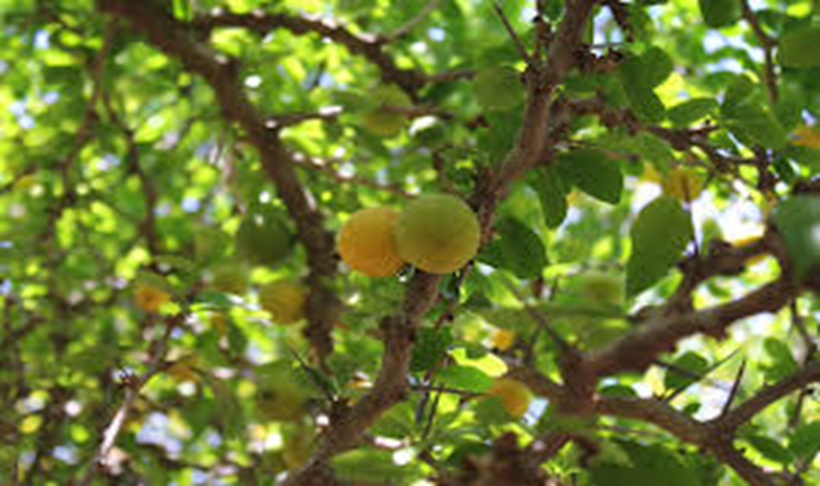
Flowers
The male and female flowers of D. caffra are found in different plants. Male flowers are cream-yellow and have many stamens. They are 3 mm long in dense clusters of 5-10 flowers. Female flowers are found in groups of up to three on stalks 4-10 mm long in leaf axils (Van Wyk & Gericke, 2000; Hacker, 2003). The flowers have no petals (Van Wyk et al., 1997). It appears that there is no strictly defined period concerning the time of flowering and fruit production. Consecutive fruits may be available throughout the year. (Legesse Negash, 1995).
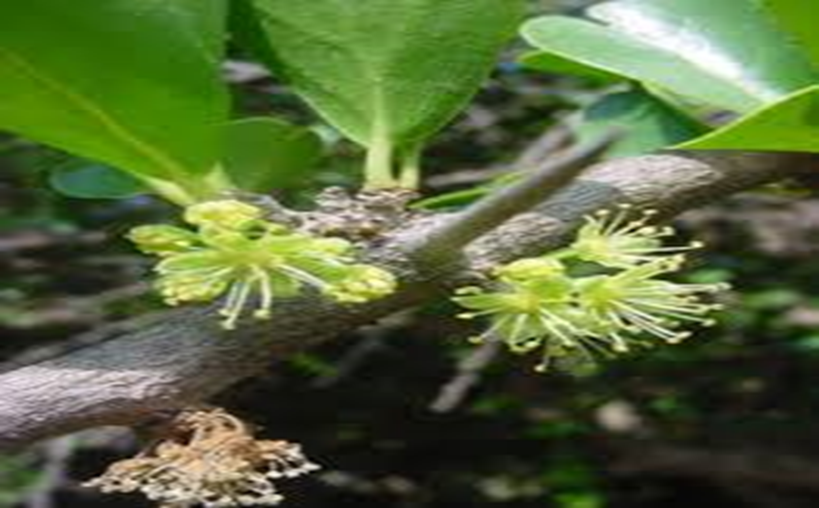
Fruits
The fruits are nearly rounded and yellowish in color. They have tough skin and apricot-textured, acidic flesh with up to 20 seeds arranged in a double ring in the center (Loots et al., 2006). The young green fruits turn yellow and later orange before natural fruit fall occurs (Albrecht, 1993). The berries are rather similar to those of D. abyssinica and are up to 60 mm in diameter The berries are produced abundantly (Legesse Negash, 1995).
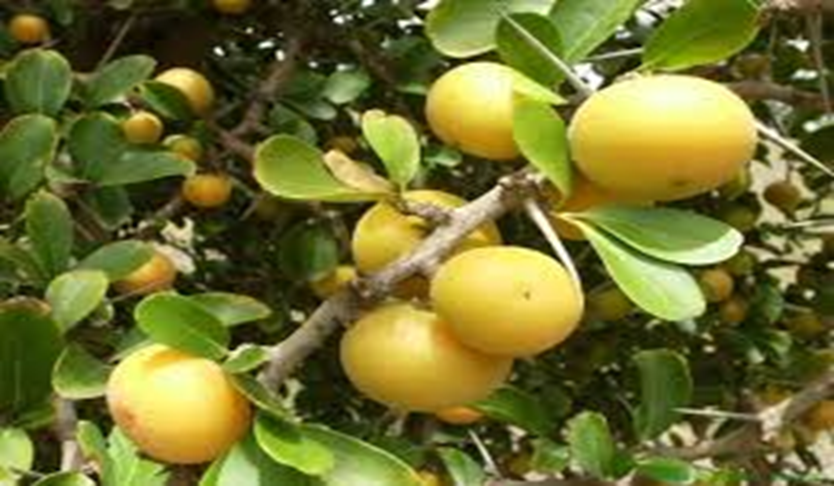
Seeds
It has been described that orthodox; mature and properly dried seeds can be stored at 3°C in airtight containers for several years (Albrecht, 1993). But the physiology of D. caffra seeds is confusing because they have been classified as both orthodox and recalcitrant by different sources (Albrecht 1993). The seeds contain an oily endosperm and the embryo has thin, flat cotyledons (Corner, 1976).Typically dry seeds are virtually wrapped within a mass of whitish and fibrous material. They measure about 5mm in diameter and are about 10mm in length. They are somewhat curved and tapered at one end and, when dry, are rather light (Corner, 1976).
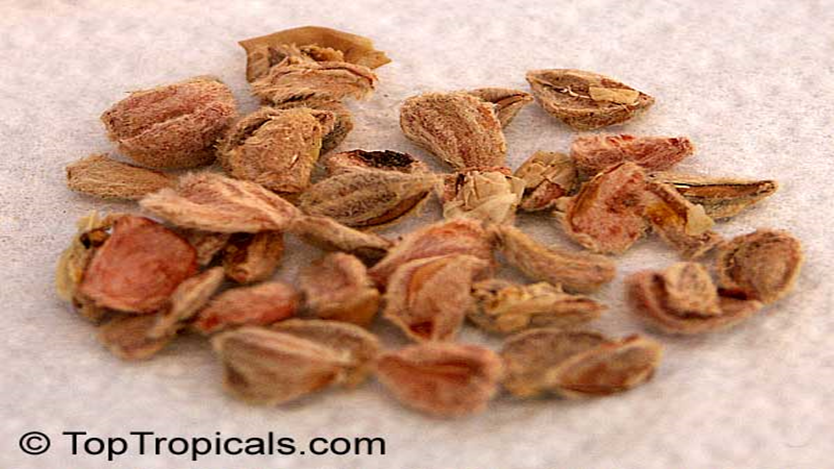
Uses and cultural aspects of D. caffra
D.caffra has diversified uses. It can be cultivated as a border partition or used to form an impenetrable hedge around a garden to keep unwanted animals and people out (Mbuya et al., 1994). The leaves are used as fodder (bulk feed for livestock) and as bee forage. The fruits are edible and are used to make excellent jams. The fruit has a high vitamin C content (17 mg / 100 g) and is most often made into jam. If the fruits are fermented, an acidic herbicide is produced (Mbuya et al., 1994).
The uses of D.caffra in agroforestry
Dovyalis caffra (Kei apple) is a tree or spiny shrub of moderate growth rate that may be planted close together to form a good hedge (Epenhuijsen,1976). It is widely used as an effective fruiting hedge that is almost goat and some other animals proof(Epenhuijsen, 1976; Legesse Negash, 1995). The thorny hedge is ideal for discouraging thieving (Epenhuijsen, 1976). The hedge is planted around residential houses, animal sheds, and farm boundaries and as a decoration on various compounds. As an evergreen multipurpose tree/shrub, D.caffra is essential in agroforestry practice, especially as a live fence (Epenhuijsen, 1976).
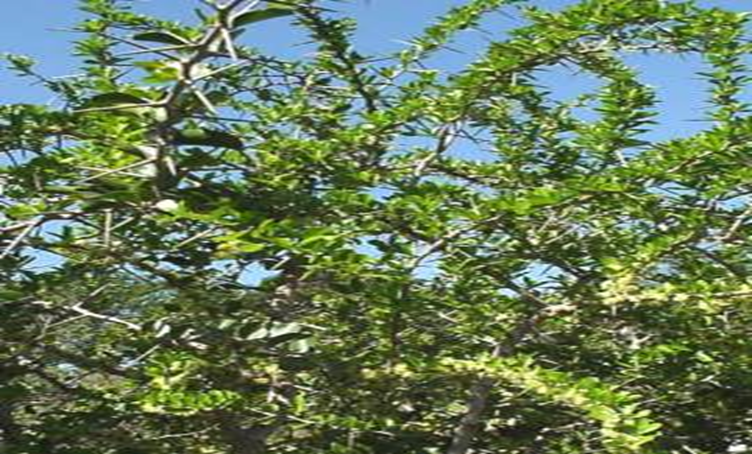
The use of D.caffra as a live fences
Live fences are familiar features throughout much of the African landscape (Rocheleau et al.,1988). The purpose of live fences may vary but mostly they are found marking small cultivated plots. Living fences are undoubtedly one of the most useful agroforestry techniques, as the need to control the movement of wild and domestic animals is a key element in most African land-use systems (Rocheleau et al.,1988). Live fences can also be constructed to protect communities from aggressive neighbors and foreign invaders. Live fences of some tree species may also form a buffer zone to protect agricultural crops and other trees from fire (Rocheleau et al.,1988). In other cases, they may demarcate areas where general access is discouraged, such as around a compound, houses, cropland, fodder lot, gardens or orchards (Rocheleau et al.,1988). Live fences may also form livestock driveways and enclosures or separate fields which are in different rotations of crop or pasture management. In most live fences, like that of D. caffra, the fence as a whole is dense and impenetrable. Live fences differ from trees planted in rows primarily for soil conservation and improvement or for fodder or fuel wood production, as in alley cropping, or from trees planted in contour vegetation strips (Rocheleau et al.,1988).
The basic design of a live fence is simple. Trees or shrubs are planted at 30 to 90-cm intervals in one or more rows, straight or in zigzags along the intended fence line (Rocheleau et al.,1988). The requirement for density varies greatly with the purpose of the fence and the woody species used. For example, a tight fence is required to keep out young goats, but if small animals are not a concern, a series of sturdy wooden stems may be adequate (Rocheleau et al., 1988). Thorny trees, shrubs, and vines which can twine through and over the fence are often included to make it more impenetrable (Rocheleau et al., 1988).
According to a study by Guggenberger et al. (1989), live fence establishment is normally done by households that have made a permanent settlement in villages; they plant hedges around their compounds for privacy and to exclude free-grazing cattle. Depending on the site conditions, live fence species may include, Ziziphus Abyssinia, Z. mauritiana, Z. mucronate, Dovyalis caffra, Senna Somalia, Erythrina Abyssinia, and fruit trees like Psidium guajava (Rocheleau et al.,1988; Otsyina et al.,1997). These trees produce strong and effective fences, they coppice profusely with many strong and fast-growing branches which could prevent the effect of animals on protected assets (Rocheleau et al.,1988; Otsyina et al.,1997). Of the above-mentioned species, D.caffra plays the leading role because of its thorniness and dense and impenetrable hedge (Rocheleau et al.,1988). The spacing between trees can be narrowed to form an impenetrable hedge around homesteads, gardens, and croplands to keep out unwanted animals (Epenhuijsen, 1976).
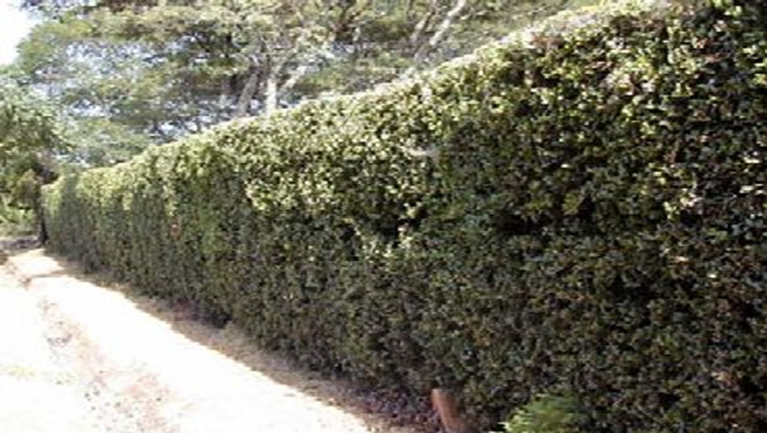
The use of D.cafffra as a bee forage
D.caffra is very valuable for its abundant pollen and nectar throughout the day. Bees are also important pollinators for setting fruit (Fichtl and Admasu Adi, 1994). In arid climates, there are reports that bees suck the juice of damaged fruits (Fichtl and Admasu Adi, 1994). Where there are dense stands of D caffra the bees store a significant surplus of honey and the tree is therefore an important honey source. There it is recommended for planting to increase honey production (Fichtl and Admasu Adi, 1994).
Food Uses
The acidic nature of the fruit of D. caffra makes it difficult to eat simply even when it is fully ripe (Morton,1987). It is reported that fresh ripe fruits contain 83 mg ascorbic acid per l00 g and 3.7% pectin. Therefore, it is best cut in half, peeled, the seeds taken out, sprinkled with sugar, and allowed to stand for a few hours before serving as a dessert or in fruit salads. The halves can stand only a few minutes of cooking before they turn into sauce. Simmered briefly into syrup, then they make excellent shortcakes. D.caffra fruit is also made into jam and jelly, and when semi-ripe into pickles (Morton, 1987)
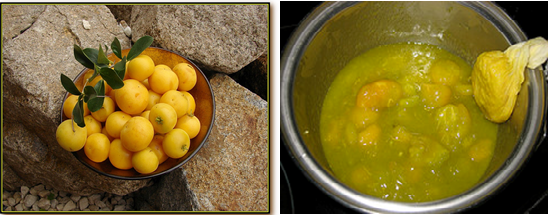
It has been reported by Scientists in Egypt that D. caffra fruit contains about 15 amino acids namely: alanine, 0.41 %; arginine, 0.36%; aspartic acid, 0.96%; glutamic acid, 2.00%; glycine, 0.39%; histidine, 0.10%; isoleucine, 0.25%; leucine,0.75%; lysine, 0.36%; methionine + valine, 0.28%; phenylalanine, 0.40%; proline, trace; serine, 0.48%; threonine, 0.34% (Nerd & Aronson, 1994). In another report by Morton (1987), it has been found that the fruit contains up to 117mg of ascorbic acid (vitamin C) per 100 gm of fruit.
Herbicidal uses
The term allelopathy originated from the Greek word `allelon’ meaning `each other’ and ‘pathos’ meaning ‘suffering’ and was coined by plant physiologist, Hans Molisch, University of Vienna, Austria (Gross, 1999). ‘Pathos’ also means `feeling’, or `sensitive’ and could therefore be used to describe both positive (sympathetic) and negative (pathetic) interactions (Gross, 1999). D.cafffra (Kei apple) exhibits allelopathy properties like some other species of plants. This means that its roots excrete growth inhibitors, which prevent the occurrence of other plants in its vicinity. Investigators in Egypt have demonstrated that the roots stem and fruit, but not the leaves and branches, possess antibiotic properties (Morton, 1987). Hence, it is used as a biological control of herbal weeds.
Additional Uses of D. cafra
In addition to the aforementioned uses, D. cafra is used as an air recycler to combat global warming, as soil nourishment, for compost making, as a mulch, as an excellent habitat and fertilizer derivation, as animal fodder, for erosion control/windbreaker and mixed tree/crop systems, for planting as farmers' incentive, as an off-farm income source, as cash crops, as a viable source of saving (Li et al. 2018) and many other direct and indirect benefits.
Management of D. caffra
Seed preparation
D.caffra is a tree crop, which is currently under intensive research. This is because its fruits have been identified as one of the forest products which have the potential to improve people’s health (Loots et al., 2006). After collection, the fruits are soaked in water for 2-3 days. The water is then drained off and the fruit is squeezed by hand to separate the seeds from the pulp. After washing with water, the seeds can be dried and stored for a short period at room temperature (Joker, 2000; Bujulu & Mkenda, 2002). Its seed germination is 60-90% within 18-20 days, or even faster under good environmental conditions. Fruit is best collected from the ground since the plant is thorny. The seeds do not require any kind of treatment (Joker, 2000; Bujulu & Mkenda, 2002).
There are a number of ways used to improve the germination of seeds (Hossain et al., 2005):
1. Scarification by Sulphuric acid: This is the effective and extensively used way of germination enhancement (Narbona et al., 2006); Nadjafi et al., 2006; Travlos et al., 2007. Olvera-Carillo et al., 2003).
2. Hot water treatment: This is also another effective and proven seed germination improvement method (Delanoy et al., 2006).
3. Abrasion against sandpaper: Here, the seed is rubbed by sandpaper until part of the seed coat is removed and then treats with auxins (Chuanren et al., 2004).
Despite the presence of the aforementioned treatment methods, D. caffra is a new crop that needs a lot of research on how to domesticate it. Therefore, there is a lack of documented information on various ways of enhancing germination of its seeds (Chuanren et al., 2004). But we can sow fresh seeds for the best germination results until research results reveal the best method.
Propagation by seeds
Propagation of D. caffra is normally by seeds (Bujulu & Mkenda, 2002). This is because seeds germinate readily and propagation by seeds is much simpler compared to vegetative propagation. However, there are a number of challenges surrounding propagation of D. caffra trees through seeds. These problems include the fact that the seeds have hard and fibrous coats (Joker, 2000; Bujulu & Mkenda, 2002). One of the factors that limit the germination of seeds is dormancy. Besides, the seeds of D. caffra display a very confusing physiology that makes it difficult to apply methods that improve germination (Albrecht, 1993). Joker (2000) showed that the seeds possess a certain degree of dormancy. It is also known that dormancy does not exist in recalcitrant seeds of Kei apple since after harvest they proceed straight to germination (Hacker, 2003).
On the other hand, seed germination is affected by other factors other than dormancy and hard-seed coats including maturity of fruits when harvested (Epkong, 2008; Samarah et al., 2003). This is because fruit maturity stage, at which seeds are extracted, has a marked influence not only on the longevity but also on the viability period of seeds. Hamilton & Midcap (1981) are of the view that there are no set rules in determining when seeds of a particular plant can be collected. But physical appearances such as color can be used to select the correct harvesting time.
The other challenge of propagation by seed is plants that repropagated by seeds take two or more years before flowering compared to those propagated vegetatively (Joyner, 2002; Jooste, 2004). Moreover, in sexual propagation, D.caffra seeds lose viability after a very short period of time. Because of the often-poor storability and high moisture content at harvest, the seed has been considered recalcitrant (Joyner, 2002; Jooste, 2004). The seed tolerates desiccation, however, and in a trial in Kenya, fresh seed dried down to as low as 4% mc germinated nearly 97% (Omondi, WK. Thomsen & S. Diklev, 2000). If the seed is properly dried and stored at 6-10% moisture content in air-tight containers at 3°C, it can remain viable for several years (Albrecht, J., 1993).
On the other hand, seeds germinate readily when fresh and seedlings mature and begin to bear fruits in 4 or 5 years. Dried seeds are normally soaked before sowing so as to soften the outer hard fibrous coat (Bujulu & Mkenda, 2002). It was proved by the authors that when soaked, the D. caffra seeds take less time for the seedling to emerge after sowing. It also minimizes the need for constant watering during the dry season, and the use of labor and irrigation water (Bujulu & Mkenda, 2002).
Propagation by cuttings
Vegetative propagation by stem cuttings could help meet the current and future seedling demand of D. caffra. It could also act as an alternative to counteract challenges posed by storage behavior (recalcitrance). This approach to plant propagation is not a new concept as it has been extensively used in the field of biotechnology (Leakey et al., 1982b). Plant feeders prefer propagation by stem cuttings as it is economical, rapid, and simple and requires less space (Leakey et al., 1982b). The use of stem cuttings in propagation makes it possible to propagate young trees, which have not yet produced flowers (Hartmann et al., 1997; Keesey & Lerner,2002). However, successful rooting necessitates a propagation environment that keeps physiological stress at minimum levels (Leakey, 2004, Leakey et al.,1982a).
Although some studies show that other tree species root without use of growth regulators, the potentiality of stem cutting to root is also dependent on the use of root stimulators (Truman et al., 2007; Leakey et al, 1982b; Shiembo et al., 1996; LaPierre, 2001; Ozel et al., 2004; Blythe et al., 2004). The other factor which creates a suitable environment for rooting of stem cuttings is the propagation medium (Laubscher & Nadakidemi, 2008). Other studies (LaPierre, 2001; Puri & Verma,1996; Kibbler et al., 2003; Negash, 2002; Agbo & Obi, 2004; Ozel et al., 2004) show that the physiological age of cutting should also be considered for successful root formation. There is a speculation that softwood and semi hard wood cuttings are the most likely to develop roots hile hardwood cuttings are less likely (Welch Keesey & Lerner, 2002).
In a study by Hae and Funnah (2011), it has been shown in the results of the experiment that for vegetative propagation the best rooting media was river sand. Since the age of cuttings is the other factor important for rooting of stem cuttings, hardwood cuttings were the best cuttings. On the other hand, the growth enhancers used were 4-indole-3-butyric acid: 1g/kg ,4-indole-3-butyric acid: 3g/kg, 4-indole-3-butyric acid: 8g/kg and 4-indole-3-butyric acid: 10g/l + 1-Naphthy-acetic acid 5g/ l. The concentration of IBA and NAA is different in different growth enhancers and there was evidence of an increase in rooting percent with an increasing concentration of IBA (Ibanèz-Torres,2004).
The interaction between propagation medium, growth regulator and cutting age had also affected rooting percent, root length and root number highly. In general terms percent rooting, root length and root number were superior where hardwood cuttings were treated with Dip ‘n Root (4-indole-3-butyric acid: 10g/l + 1-Naphthy-acetic acid 5g/ l) and when rooted in river sand (RSND). This indicates that all the three factors have to be given consideration for successful rooting of stem cuttings (Hae and Funnah, 2011).
Pruning and trimming
For some species of trees/shrubs as soon as branches in the main fence structure have grown long enough, they can be cut or bent and woven in between the stems of the woody plants to manage the live fences. This will work well to reinforce the fence, especially if the branches are thorny (Mbuya et al. 1994). Once well established, living fences of D. caffra require little management. The tree has a moderate growth of 60 cm/year (Mbuya et al. 1994). It responds well to pruning and grows well in either full sun or light shade. To maintain a good live fence, the planted D. caffra trees should be trimmed regularly (Katende et al. 1995).
Pruning
When a tree or shrub is pruned there may be one or more objectives in mind. The general objective
of pruning is to produce strong, healthy, and aesthetically attractive plants that complement our property. To elaborate more the specific objectives are as follows (Harris et al, 2004).
- To avoid dead or diseased wood and sometimes to free the subject of pest or disease-carrying material
- To correct or improve shape: for example, a branch may be considered to spoil the general outline
- To maintain or improve flower display. For this to be fully effective, correct timing is very important, for the growth and flowering habit of trees and shrubs in particular must be taken into account when deciding when to prune. This will be found to vary with position and locality and with such general conditions as soil type, rainfall, exposure to wind, and sunshine. Hence, as D.caffra trees grow, they must be pruned, usually on an annual basis (Harris et al, 2004).
Trimming
As this tree/shrub species grows, it should be trimmed on both sides and eventually on top so that it will not take up more space than necessary or cast too much shade on adjacent land (Annonymous********2015). It is important to cut tree branches properly. The trimming height depends on individual's decision (Epenhuijsen, 1976). Branches are often half cut and then ripped off the tree leaving long scars in the bark. This damage can kill the trees or limit their growth. Hence, care must be taken while trimming. Individual trees or all the trees of the matured D.caffra can be harvested as required. The approach will depend on local priorities and the availability of labor for their removal (Wesonga, et al., 2002).
Distribution and Uses in Ethiopia
In Ethiopia, there are no much research findings regarding distribution and uses of D.caffra but some studies show its high distribution and uses. For instance a study by Habtamu Hailu in homegardens of Sebeta town Oromyia region Ethiopia showed a high frequency of D.caffra (66.6) next to seven other species (Habtamu Hailu, 2011). Another study at Holeta town Ormya region also have shown Dovyalis caffra was the most prominent shrub species together with Rhamnus prinoides and Catha edulis, in the study area (Mekonnen Amberber, 2011). This study has also shown D.caffra is selected and used as a live fence because of its thorniness. The people in the study area also use edible fruits as food (Mekonnen Amberber, 2011).
Even though there are some studies showing the distribution and uses of D.caffra here and there in Ethiopia, there are no detailed research about this important specie. Therefore, it is required to undertake all-round research to get the maximum benefit from it.
Conclusion
D.caffra is an evergreen, drought and frost-resistant fruit tree or shrub. Because of its deep rooting tap root system, it is adapted to diversified environments as it captures both water and nutrients from deeper part of the soil.There is no strictly defined period of flowering and fruiting and hence its fruits may be available throughout the year.
D. caffra grows well in an altitude range of 1500-2600m and a rain fall of 500-1500mm per year. Even though it does well in almost all types of soil, it prefers well-drained soils. It can simply be propagated by seeds (the simplest and common way) and vegetatively by using hard wood cuttings. It has both direct tree products such as food and fodder and services like soil and water conservation, living fences and microclimate amelioration.This valuable tree specious can be managed to minimize competition for light, nutrients and water with agricultural crops and vegetables by pruning and trimming. Generally, D. caffra (Kei apple) is a promising multipurpose tree/shrub that can be used for different agroforestry practices.
Personal reflections
From the findings of the review, D.caffra can be grown in almost all types of soils except waterlogged sites. It can also be grown on salt affected soils. Therefore, we can use this valuable tree for rehabilitation of degraded lands to protect our experimental sites as a live fence and to rehabilitate salt affected soils in both of our sub-projects namely "Rehabilitation of degraded lands for sustainable natural resource management and utilization" and "Developing technologies and information on trees and shrubs on degraded lands".
References
- Agbo, C. U., & Obi, I. U. (2007). Variability in propagation potentials of stem cuttings of different physiological ages of Gongronema latifolia Benth. World Journal of Agricultural Sciences, 3(5), 576-581.
View at Publisher | View at Google Scholar - Schmidt, L. (2000). Guide to handling of tropical and subtropical forest seed (pp. 263-303). Humlebaek: Danida Forest Seed Centre.
View at Publisher | View at Google Scholar - Blythe, E. K., Sibley, J. L., Ruter, J. M., & Tilt, K. M. (2004). Cutting propagation of foliage crops using a foliar application of auxin. Scientia Horticulturae, 103(1), 31-37.
View at Publisher | View at Google Scholar - Bujulu E, Mkenda E.2002. Propagation of Kei apple (Dovyalis caffra Warb.). Proceedings of the horticulture seminar of sustainable production in the tropics, 3rd to 6th October 2002. Jomo Kenyatta University of Agriculture and Technology.
View at Publisher | View at Google Scholar - Chuanren, D., Bochu, W., Wanqian, L., Jing, C., Jie, L., & Huan, Z. (2004). Effect of chemical and physical factors to improve the germination rate of Echinacea angustifolia seeds. Colloids and Surfaces B: Biointerfaces, 37(3-4), 101-105.
View at Publisher | View at Google Scholar - Ocampo-López, A., Dávila-Aranda, P., Flores, A., & Pritchard, H. W. (2003). Longevity of Mammillaria super-texta seeds under ultra-dry long-term storage. Seed Conservation Turning Science into Practice, Kew: The Royal Botanic Garden.
View at Publisher | View at Google Scholar - Stanstrup, J., Rusch, A. M., Agnolet, S., Rasmussen, H. B., Mølgaard, P., Van Staden, J., ... & Staerk, D. (2010). Itoside A and 4-hydroxytremulacin from Dovyalis caffra and Dovyalis zeyheri. Biochemical Systematics and Ecology, 38(3), 346.
View at Publisher | View at Google Scholar - WEBER, D. R. F. (1988). Agroforestry in dryland Africa.
View at Publisher | View at Google Scholar - Delanoy, M., Van Damme, P., Scheldeman, X., & Beltran, J. (2006). Germination of Passiflora mollissima (Kunth) LH Bailey, Passiflora tricuspis Mast. and Passiflora nov sp. seeds. Scientia Horticulturae, 110(2), 198-203.
View at Publisher | View at Google Scholar - Distribution of Dovyalis caffra. Anonymous* 2015.
View at Publisher | View at Google Scholar - Dovyalis caffra livefence Annonymus****** 2015.
View at Publisher | View at Google Scholar - Edible fruits and Jam (Jelly) from ripe fruits of D.caffra .Annonymous*******2015
View at Publisher | View at Google Scholar - van Epenhuijsen, C. W. (1976). Deciduous fruits in Tanzania. Deciduous fruits in Tanzania.
View at Publisher | View at Google Scholar - Ekpong, B. (2009). Effects of seed maturity, seed storage and pre-germination treatments on seed germination of cleome (Cleome gynandra L.). Scientia Horticulturae, 119(3), 236-240.
View at Publisher | View at Google Scholar - Flowers of Dovyalis caffra. Annonymous*** 2015
View at Publisher | View at Google Scholar - Gross, E. (1999). Allelopathy in benthic and littoral areas: case studies on allelochemicals from benthic cyanobacteria and submersed macrophytes.
View at Publisher | View at Google Scholar - Guggenberger, C., Ndulu, P., & Shepherd, G. (1989). After Ujamaa: Farmer needs, nurseries and project sustainability in Mwanza, Tanzania. ODI, Agricultural Administration Unit.
View at Publisher | View at Google Scholar - Hacker B.2003. Kei apple – Dovyalis caffra – Yet another Thorny Weed? BRAIN Newsletter. No. 24, May 2003.
View at Publisher | View at Google Scholar - Hae, M. and Funnah S.M.2011.The effect of propagation media and growth regulars on rooting potential of Kei apple (Dovyalis caffra) stem cuttings at different physiological ages. Crop Science Programme, Faculty of Science and Technology, North-West University, Mafikeng Campus, Life Science Journal, 2011:8(S2).
View at Publisher | View at Google Scholar - Hamilton DF, MIDCAP TJ.1981. Seed Propagation of Woody Ornamentals. Circular 414. Florida Cooperative Extension Service, Institute of Food and agricultural Sciences. University of Florida.
View at Publisher | View at Google Scholar - Harris, R. W. (1992). Arboriculture: integrated management of landscape trees, shrubs, and vines (No. Ed. 2). Prentice-Hall International.
View at Publisher | View at Google Scholar - Hartmann, H. T., & Kester, D. E. (1975). Plant propagation: principles and practices. Prentice-Hall.
View at Publisher | View at Google Scholar - Hossain MA, Arefin MK, Khan BM, Rahman MA.2005. Effects of seed treatment on germination and seedling growth attributes of Horikati (Terminalia chebula. Retz) in the nursery. J. Agric & Biol. Sci. 1:135-141.
View at Publisher | View at Google Scholar - Ibáñez-Torres, A. (2004). Rooting experiments with Euphorbia lagascae cuttings. Anales de biología, vol. 26, 2004.
View at Publisher | View at Google Scholar - Jooste M.2004. Dovyalis caffra. (Hook & Harv) Warb. Ecoport country programme. Republic of South Africa.
View at Publisher | View at Google Scholar - Joyner G .2002. The Kei apple. Manatee. Rare fruit news. September 2002.
View at Publisher | View at Google Scholar - Katende A.B., Ann Birnie and Bo Tengnas.1995. Useful trees and shrubs for Uganda. Identification, Propagation and Management for Agricultural and Pastoral Communities. Regional Soil Conservation Unit (RSCU), Swedish International Development Authority (SIDA).
View at Publisher | View at Google Scholar - Kibbler, H., Johnston, M. E., & Williams, R. R. (2004). Adventitious root formation in cuttings of Backhousia citriodora F. Muell: 1. Plant genotype, juvenility and characteristics of cuttings. Scientia horticulturae, 102(1), 133-143.
View at Publisher | View at Google Scholar - LaPierre, L. M. (2001). Vegetative propagation of Cecropia obtusifolia (Cecropiaceae). Revista de Biología Tropical, 49(3-4), 973-976.
View at Publisher | View at Google Scholar - Laubscher, C.P., & Ndakimedi, P.A.2008.The effects of Indole Acetic Acid and rooting mediums on rooting of Leucadendron laxum (Proteaceae) in a shed tunnel environment. Am. Euras. J. Agric & Environ. Scie. 4, 326 – 331.
View at Publisher | View at Google Scholar - Leakey RRB. 2004.Clonal approaches to hardwood forestry in the tropics: In prospects for high value hardwood timber plantations in the dry tropics of Northern Australia, Mareeba, 19th– 21st October 2004. p1-12.
View at Publisher | View at Google Scholar - Leakey, R. R. B., Last, F. T., & Longman, K. A. (1982). Domestication of tropical trees: an approach securing future productivity and diversity in managed ecosystems. The Commonwealth Forestry Review, 33-42.
View at Publisher | View at Google Scholar - Leakey RRB, Chapman VR, Longman KA. 1982a.Physiological studies for tropical tree improvement and conservation: factors affecting root initiation in cuttings of Triplochiton Scleroxylon. For. Ecol. Manage. 4:53-66.
View at Publisher | View at Google Scholar - Legesse Negash (1995). Indigenous Trees of Ethiopia: Biology, Uses and Propagation. Addis Ababa: Department of Biology, Addis Ababa University. Printed: SLU Reprocentralen, Umea (Sweden).
View at Publisher | View at Google Scholar - Li, X., Siddique, K.H.M. 2018. Future Smart Food -Rediscovering hidden treasures of neglected and underutilized species for Zero Hunger in Asia, Bangkok, , in: Siddique, X.L.a.K.H.M. (Ed.). p. 242.
View at Publisher | View at Google Scholar - Loots, D. T., van der Westhuizen, F. H., & Jerling, J. (2006). Polyphenol composition and antioxidant activity of Kei-apple (Dovyalis caffra) juice. Journal of agricultural and food chemistry, 54(4), 1271-1276.
View at Publisher | View at Google Scholar - Management of Dovyalis caffra. Anonymous********2015.
View at Publisher | View at Google Scholar - Mbuya, L. P., Msanga, H. P., Ruffo, C. K., Birnie, A., & Tengnas, B. O. (1994). Useful trees and shrubs for Tanzania. Identification, propagation and management for agricultural and pastoral communities. Regional Soil Conservation Unit (RSCU)/Swedish International Development Authority (SIDA). Swedish Embassy, Nairobi.
View at Publisher | View at Google Scholar - Morton J.1987.Kei apple (Dovyalis caffa (Warb.)Warb.) in fruits of warm climate. Miami, Florida.
View at Publisher | View at Google Scholar - Nadjafi, F., Bannayan, M., Tabrizi, L., & Rastgoo, M. (2006). Seed germination and dormancy breaking techniques for Ferula gummosa and Teucrium polium. Journal of Arid Environments, 64(3), 542-547.
View at Publisher | View at Google Scholar - Narbona, E., Ortiz, P. L., & Arista, M. (2006). Germination variability and the effect of various pre-treatment on germination in the perennial spurge Euphorbia nicaeensis All. Flora-Morphology, Distribution, Functional Ecology of Plants, 201(8), 633-641.
View at Publisher | View at Google Scholar - Negash, L. (2002). Successful vegetative propagation techniques for the threatened African pencil cedar (Juniperus procera Hoechst. ex Endl.). Forest ecology and management, 161(1-3), 53-64.
View at Publisher | View at Google Scholar - Nerd, A., Aronson, J. A., & Mizrahi, Y. (1994). Introduction and domestication of rare and wild fruit and nut trees for desert areas. WANATCA Yearbook, 18, 42-53.
View at Publisher | View at Google Scholar - Olvera-Carrillo, Y., Márquez-Guzmán, J., Barradas, V. L., Sánchez-Coronado, M. E., & Orozco-Segovia, A. (2003). Germination of the hard seed coated Opuntia tomentosa SD, a cacti from the México valley. Journal of Arid Environments, 55(1), 29-42.
View at Publisher | View at Google Scholar - Omondi, W., Thomsen, K. and Diklev, S.2000. Screening of Dovyalis caffra at Kenya Forestry Seed Centre.IPGRI/DFSC Newsletter no. 6.
View at Publisher | View at Google Scholar - Otsyina, R., Asenga, D., Makweta, A. and Maduka, S.1997.AnnualProgress Report.HASHI/ICRAF Agroforestry Research project. 68pp.
View at Publisher | View at Google Scholar - Ozel CA, Khawar KM, Marica S, Arslan O,Sebahattin O.2004. Induction of ex vitro adventitious roots on softwood cuttings of Centaurea tchihatchaffii Fisch. Et. May. Using indole-3-butyric acid and - naphthalene aceteic acid. Int. J. Agric. Biol. 8:66-69.
View at Publisher | View at Google Scholar - Palgrave, K.C.1991. Trees of Southern Africa, 2. ed. Struik Publishers, Cape Town, SA.
View at Publisher | View at Google Scholar - Palgrave, K.C.1988.Trees of Southern Africa, C.S., Cape Town, South Africa: Struik Publishers
View at Publisher | View at Google Scholar - Palmer, E.1977. A Field Guide to the trees of Southern Africa. William Collin Sons and Co.Ltd. Johannesburg, South Africa.
View at Publisher | View at Google Scholar - Physical appearance of Dovyalis caffra plant. Annonymous** 2015
View at Publisher | View at Google Scholar - Puri, S., & Verma, R. C. (1996). Vegetative propagation ofDalbergia sissooRoxb. using softwood and hardwood stem cuttings. Journal of arid environments, 34(2), 235-245.
View at Publisher | View at Google Scholar - Fichtl, R., & Adi, A. (1994). Honeybee flora of Ethiopia. Margraf Verlag.
View at Publisher | View at Google Scholar - WEBER, D. R. F. (1988). Agroforestry in dryland Africa.
View at Publisher | View at Google Scholar - Samarah, N. H., Allataifeh, N., Turk, M., & Tawaha, A. R. (2003). Effect of maturity stage on germination and dormancy of fresh and air‐dried seeds of bitter vetch (Vicia ervilia L.). New Zealand Journal of Agricultural Research, 46(4), 347-354.
View at Publisher | View at Google Scholar - Seeds of Dovyalis caffra. Annonymous***** 2015.
View at Publisher | View at Google Scholar - Shiembo, P. N., Newton, A. C., & Leakey, R. R. B. (1996). Vegetative propagation of Irvingia gabonensis, a West African fruit tree. Forest Ecology and Management, 87(1-3), 185-192.
View at Publisher | View at Google Scholar - Travlos, I. S., Economou, G., & Karamanos, A. I. (2007). Germination and emergence of the hard seed coated Tylosema esculentum (Burch) A. Schreib in response to different pre-sowing seed treatments. Journal of Arid Environments, 68(3), 501-507.
View at Publisher | View at Google Scholar - Trueman, S. J., & Peters, R. F. (2006). Propagation of Wollemi pine from tip cuttings and lower segment cuttings does not require rooting hormones. Scientia horticulturae, 109(4), 394-397.
View at Publisher | View at Google Scholar - Van Wyk, B. E., Oudtshoorn, B. V., & Gericke, N. (1997). Medicinal Plants of South Africa. Briza.
View at Publisher | View at Google Scholar - Van Wyk, B. E., & Gericke, N. (2000). People's plants: A guide to useful plants of Southern Africa. Briza publications.
View at Publisher | View at Google Scholar - Venter, F., & Venter, J. A. (1996). Making the most of indigenous trees. Briza publications.
View at Publisher | View at Google Scholar - Welch-Keesey, M. M. and Lerner, B. R.2002. New Plants from Cuttings [online]Purdue University, Consumer Horticulture, Department of Horticulture and Landscape Architecture, HO-37.
View at Publisher | View at Google Scholar - Wesonga, J. M., Losenge, T., Ndung’u, C. K., Ngamau, K., Njoroge, J. B. M., Ombwara, F. K., ... & Stützel, H. (2002). Proceedings of the second horticulture seminar on sustainable horticultural production in the tropics.
View at Publisher | View at Google Scholar